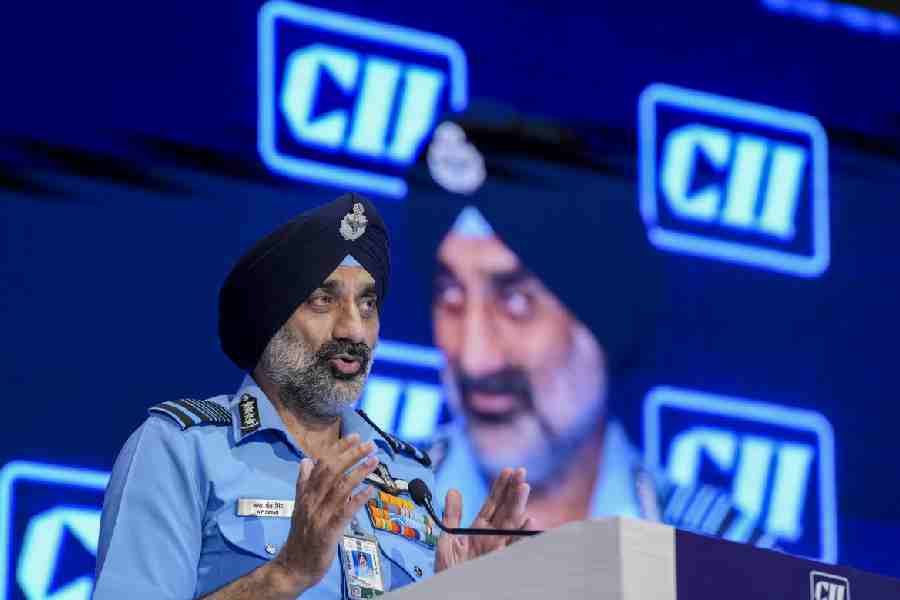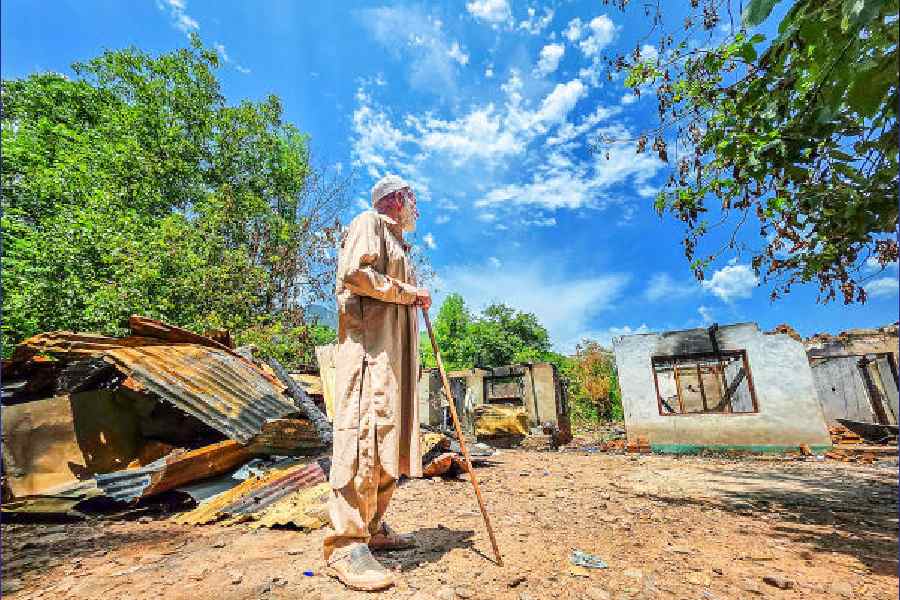 |
Nitish Kumar’s lips are sealed. No matter how much you coax and cajole him, the Bihar chief minister won’t hazard a guess about the state election result. And that’s not because he has any doubts about returning to power. He just wants to be careful.
There’s good reason for that.
Bihar has witnessed an uncharacteristic spurt in votes in the six-phase election to the 243-seat state assembly that got over yesterday. Nearly 50 per cent of the electorate cast its vote, versus 40 per cent in 2005.
In the national context, a high turnout usually spells doom for the incumbent. But in Bihar, it could well mean a landslide victory for Nitish Kumar, 59. A STAR News-Nielsen opinion poll predicts a decisive win for the ruling alliance of the Janata Dal (United) and the Bharatiya Janata Party, which, it says, may win 170 seats this time, up from 143 in 2005.
Yet the chief minister prefers to keep mum. “I won’t say anything about the poll result. Let the people decide,” he says, sitting on a roofed patio in his official residence in Patna. The socialist leader, in his trademark white kurta and pyjamas, appears relaxed, kicking off his plastic flip-flops.
In the last five years, the JD(U) boss has established the rule of law in a state that was once derided as the “Republic of Bihar” for its lawlessness. “Nitish Kumar has resurrected the state in Bihar. Few had thought it possible,” says economist Shaibal Gupta of the Patna-based Asian Development Research Institute.
Indeed, his government has convicted 54,176 criminals since 2006. The police force has been beefed up too, with the government more than doubling the police budget to Rs 2,900 crore in 2010. In fact, Kumar attributes the high turnout in the election to the transformed law and order situation. A bomb explosion near a polling station in Danapur to scare off people actually had them rushing to vote. “They realised that staying away from voting would only help those who had brought about a jungle raj in Bihar,” he says, alluding to the 15-year-old rule of the Rashtriya Janata Dal led by Lalu Prasad and Rabri Devi that he replaced in 2005.
Deputy chief minister Sushil Kumar Modi of the BJP says the state’s plan expenditure stands at a “whopping” Rs 20,000 crore. “The RJD government’s plan expenditure for their 15-year rule totalled Rs 25,000 crore,” Modi, who is also finance minister, adds.
PAST PERFECT What he has done in the last five years 1 Cracked down on criminals 2Built 15,000 new primary schools and appointed 2,00,000 primary teachers. Built scores of rural roads and bridges. 3 Given free cycles to girls in classes IX and X. Girls’ enrolment in schools has jumped from 1,60,000 in 2006-07 to 4,90,000 in 2009-10. 4 Reserved 50 per cent seats for women in all tiers of panchayats and urban bodies. Reserved 20 per cent of local government seats for the “extreme backwards”. 5 Identified 22 mostly landless “extreme backward” castes as maha Dalits. They have been given small plots to set up houses under the |
Yet critics allege that the state government’s achievements are not all that they are being made out to be. Rashtriya Janata Dal (RJD) president Abdul Bari Siddiqui exclaims, “It is nothing but a jugglery of statistics and manipulation of the media.”
Siddiqui says central assistance to Bihar has gone up by more than 200 per cent over the last five years. When the Rabri Devi government went out of power in 2005, the RJD chief says the state got some Rs 12,000 crore by way of central assistance versus more than Rs 34,000 crore it has got in the current financial year. “Nitish Kumar is simply spending the Centre’s money but taking credit for the so-called development,” he says.
State Congress leader Prem Chand Mishra too says that the roads and bridges are all being built from the central funds provided under the Pradhan Mantri Gram Sarak Yojna or Rashtriya Sam Vikas Yojana. “Actually, the credit for all development works in Bihar should go to the Congress government in Delhi,” he says.
A senior IAS officer acknowledges that “more central” funds are flowing into Bihar now than five years ago. “But how many roads, schools or health centres were built by the previous government, which too had received the central funds? It is not just a question of funds but also of the political will,” he says.
The Nitish Kumar government couldn’t agree more. And it’s not just the roads and bridges that the state government has built. Nitish Kumar has done considerable work in the social sector too. The chief minister reserved 50 per cent of the seats in all three tiers of panchayats and urban bodies for women. His government also gave Class IX girl students Rs 2,000 each to buy cycles under an empowerment programme.
FUTURE BRIGHT What he plans to do in the next five years 1 Combat corruption at district, block and village levels. Ensure speedy disposal of corruption cases involving 2 Set up power plants mostly in the public sector. Bring in private investment in the energy sector. 3 Stress on the “quality” of primary education. Focus on higher education. 4 Tackle petty crimes along with serious offences. 5 Build a consensus on land reforms through informed debates in and outside the |
If Nitish Kumar does come back to power, it could be partly because of efforts aimed at empowering the “lowest of the lower” castes. Kumar has reserved 20 per cent of local government seats for “extreme backwards”. His government has identified 22 mostly landless groups among scheduled castes as “maha Dalits,” providing them with small plots, among other financial support, to build their own houses.
In the process, he has eroded the support base of Lalu Prasad and Lok Janshakti Party president Ram Vilas Paswan, who contested the assembly election together for the first time in a bid to contain Nitish Kumar. “They don’t stand a chance,” scoffs the chief minister.
But not all is well in Bihar today. Corruption, as a Patna High Court judge puts it, is eating away the vitals of the state. “The poor cannot get benefits from any scheme without greasing the palms of petty government officials or village heads,” he says. Graft, adds Mishra, has been “decentralised” in Bihar. “Earlier, you paid the ministers or senior officials to get things done. Now you have corruption at district, block and village levels.”
Many believe that corruption among the bureaucracy is on the rise because Kumar relies on officials instead of party colleagues to get things done. “He insulated civil servants from political interference so they could work fearlessly. But they now feel emboldened and are taking advantage of his faith in them,” economist Gupta says.
Nitish Kumar acknowledges that corruption is rife “at lower levels” and vows to put an end to it if he’s returned to power. He says his government passed the Bihar Special Courts Act in 2009 which allows the confiscation of properties of corrupt officials and speedy trials.
Power shortage is another issue that goes against Kumar. His government may have spent Rs 70,000 crore on development works over the last five years, but Bihar continues to reel under power cuts.
He promises to electrify all 45,103 revenue villages in the state by 2015. He says the 3,020-megawatt Nabinagar project in Aurangabad district, being set up by the railways and the National Thermal Power Corporation, will start functioning soon. The state electricity board also plans to set up a 1,320-megawatt unit in Buxar.
Kumar understands the need to radically alter the face of Bihar, for life was not easy for the young man who strayed into politics as an electrical engineering student in the early Seventies, drawn by the socialist movement of Jayaprakash Narayan.
He says he is a “family” man but that he would rather keep his family and politics apart. Unlike Lalu Prasad who recently introduced son Tejaswi as his heir apparent, Nitish squirms when asked if his engineer son Nishant will join politics. “I don’t know why I should be asked such questions,” he says, visibly uncomfortable.
But he himself has never regretted joining politics. At the end of his tenure, he says he has “done his duty” as a chief minister. To be sure, he wishes he had done more. He’d have liked to have seen land reforms in the state. But an act that he moved was opposed not just by the opposition but by his own party as well.
His party colleagues call him a workaholic. Especially since the death of his 53-year-old teacher wife Manju Sinha in 2007, Nitish has immersed himself in work. “I will do my bit as long as my health permits,” he says, rising from his chair.
The autumnal sun dips as Nitish Kumar heads for his residential office. He looks frail and tired in the gathering darkness. On the patio, the chair he has been sitting on lies empty, as if waiting for him to return.










